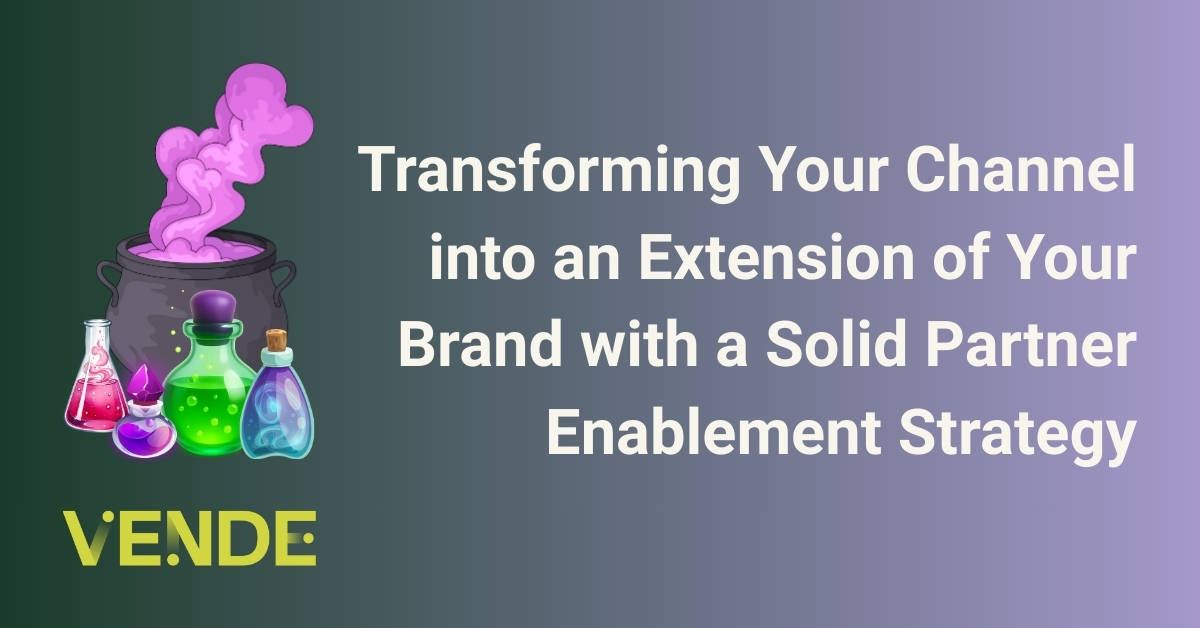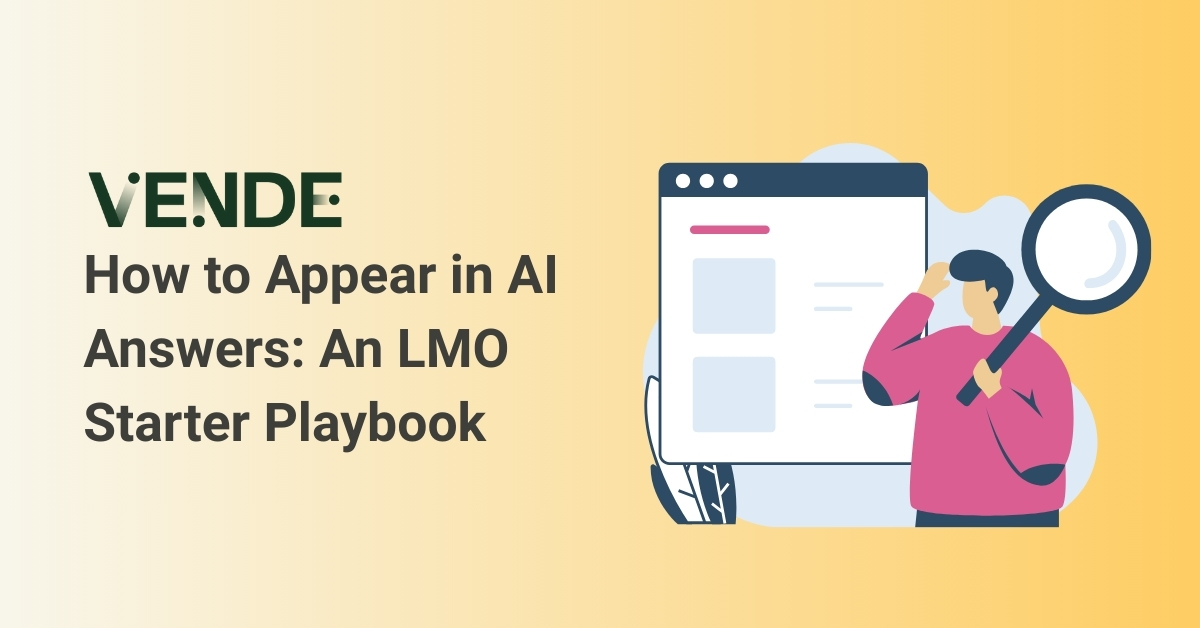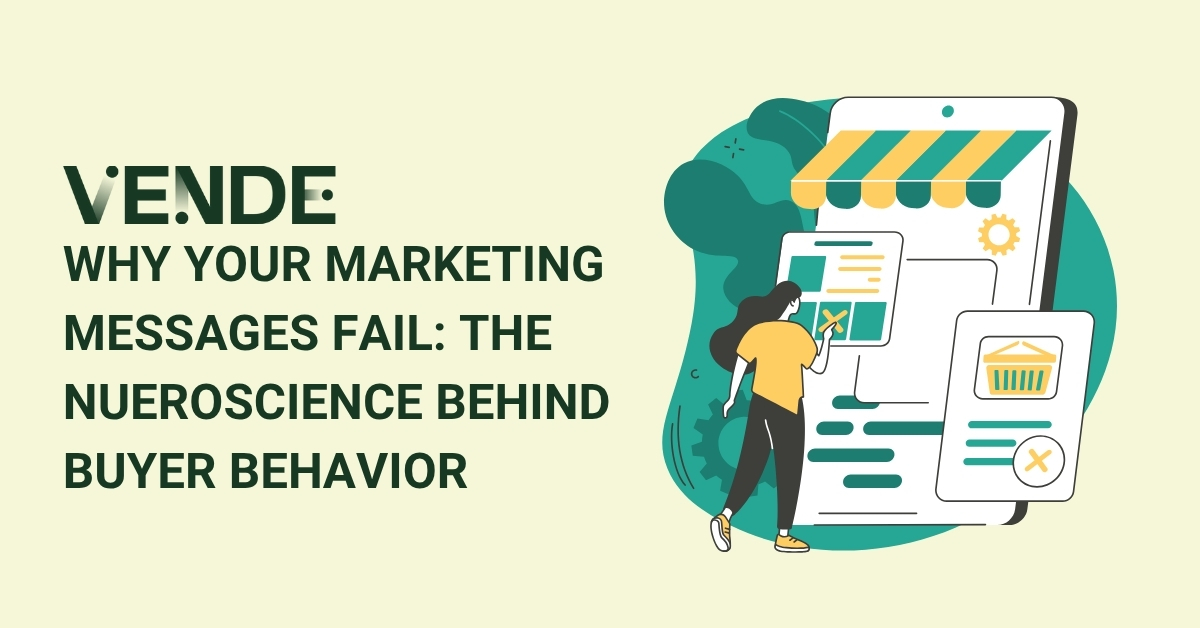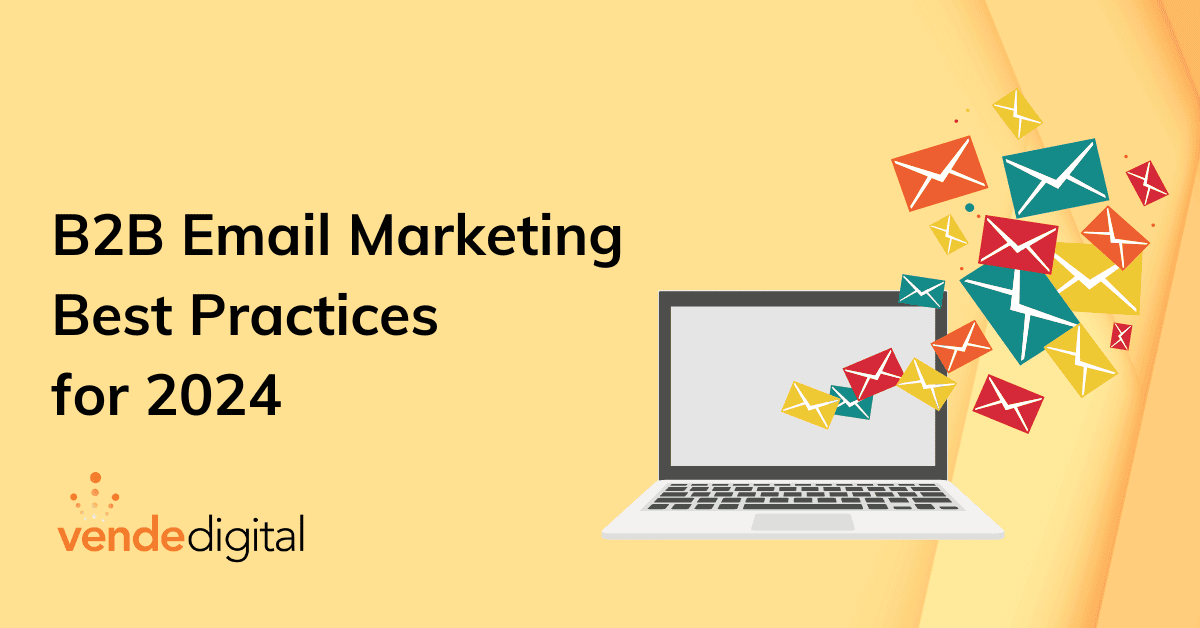
B2B Email Marketing Best Practices for 2024
How to Craft B2B Emails That Grab and Hold Attention Using Our ADHD Framework
In the high-stakes world of business-to-business (B2B) marketing, your email competes with hundreds, clamoring for attention in overflowing inboxes. Every day, our prospects face a deluge of emails, messages, and notifications while juggling tasks, meeting deadlines, and striving to keep pace. Let’s face it: we’re all living in an ADHD world now.
Grabbing and holding attention has become increasingly challenging in a world of distractions. Did you know the average human attention span has dwindled to 8 seconds? Yes, you read that correctly – our attention spans are now shorter than those of goldfish.
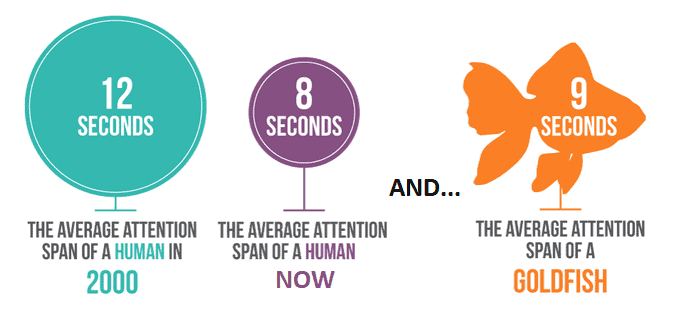
As a seasoned marketer, you’ve likely tried every demand generation trick in the book – personalization, segmentation, A/B testing -. Yet, your open rates and click-throughs still aren’t where you want them to be.
That’s why we’ve playfully developed our ADHD (pun intended) framework for B2B email marketing best practices. No, we’re not suggesting your emails should be disorganized or unfocused. This framework aims to cut through the noise and deliver messages that resonate in today’s attention-scarce environment. ADHD in our context stands for:
- Attention: How to instantly capture interest in a crowded inbox
- Direct: Delivering your message clearly and concisely
- Human: Injecting your brand’s personality to build genuine connections
- Direction: Guiding your reader towards a specific, valuable action
B2B Email Marketing Best Practices for 2024
In this article, we’ll examine these elements and show you how to craft B2B emails that survive and thrive in the ADHD era.
So, grab your favorite focus-enhancing beverage, set aside the next few minutes (if you can), and let’s dive into the world of ADHD-optimized B2B email marketing. Trust us, it will be more exciting than watching a goldfish swim laps – and far more profitable for your business.
Why B2B Email Marketing? Why Now?
Before we discuss the ADHD approach, let’s address a crucial question: Why focus on email in today’s diverse digital landscape?
Simple. Email remains the champion of direct communication. Think about it: your email list is yours. It’s not at the mercy of marketing channels like Google or LinkedIn shifting priorities or changing algorithms that can have a negative impact. When you build an email list, you create a direct line to your target audience that these external forces can’t sever.
Email also grants you access to one of the most intimate digital spaces in your potential customers’ world: their inbox. In our ADHD-driven digital age, the average professional checks their email 15 times per day, or every 37 minutes. Some studies even suggest that people check their emails as often as 74 times daily!
Each time your target audience checks their inbox, you can capture their attention, deliver value, and guide them toward meaningful action. Use email wisely, and you can become an indispensable part of their workday.
But with great power comes great responsibility. The intimacy of the inbox means that poor email practices can quickly lead to unsubscribes or spam reports. That’s why mastering the art of B2B email marketing is crucial.
In B2B Email Marketing, Attention is What Matters Most
Why the ADHD pun? In 2024, attention will be the most valuable commodity in marketing. As Gary Vaynerchuk puts it, “We’re all battling for your attention.” This battle is particularly fierce in B2B, where decision-makers are bombarded with countless emails every day. According to Radicati Group, a technology market research firm, the average office worker receives 121 emails per day.
Even if your potential customers don’t have ADHD, they are still facing distractions and competing priorities that make it difficult to focus on any one thing.
Marketing automation systems have made it easier to send emails at scale, contributing to inbox fatigue. The rise of cold emails (once considered SPAM) has exacerbated this issue.
To stand out, you need more than sophisticated technology and a list of suspects- you need a strategy that combines the art of compelling content with the science of data-driven optimization.

In the following sections, we’ll explore each element of the ADHD approach, providing you with actionable strategies you can implement immediately. By the end of this guide, you’ll have a fresh perspective on your B2B email marketing strategy and a toolkit of innovative tactics to revitalize your campaigns.
What are the benchmarks for B2B email marketing?
There are several B2B email marketing benchmarks to consider when establishing your KPIs or measuring your success. These include:
- Open Rate: >15%
- Click-Through-Rate (CTR): 2.44%
- B2B Conversion Rate: 2.5%
- Bounce Rate: 2.48%
- Unsubscribe Rate: 0.24%
These rates can vary depending on the industry, the customer’s stage in their journey, the type of content provided, and the offering.
A – Attention: Capturing Potential Customers Interest Instantly
In the B2B world, we’re not just competing with other businesses for attention; we’re competing with every email, Slack message, text, and notification that invades our prospect’s world. The first challenge is to grab attention from the moment our email lands in our potential customers’ inboxes.
Crafting Compelling Email Subject Lines
Your subject line is your first (often only) chance to capture attention. The shiny trinket makes them stop for a second and wonder if what’s inside your email is worth it.
- Personalization in email subject lines is the top driver for open rates. Personalize beyond just using the recipient’s name. Try industry-specific terms or company names. Example: “[XYZ Company Name]’s Q4 strategy is missing this key element”
- Keep subject lines short – around 40-50 characters is ideal
- Test different subject lines to see which perform best with your target audience
- Use power words in subject lines that evoke curiosity or urgency. Example: “The strategy your competitors hope you’ll ignore.”
- Ask thought-provoking questions in your subject lines. Example: “Is your MarTech stack costing you clients?”
Optimizing Preview Text
Preview text is an often overlooked feature of email marketing, but it’s prime real estate for grabbing attention. Use these 100 characters wisely:
- Create a cliffhanger that ties into your subject – Example: “You won’t believe what happened next…”
- Tease the value inside your email. For example, “Discover five secrets to double your ROI in just 30 days.”
- Keep it short and snappy – Example: “Unlock massive growth with this one tip.”
- Use numbers or statistics – Example: “According to Gartner, 80% of B2B marketers get this wrong.”
- Highlight a key benefit or offer – Example: “Save 50% on our latest product release.”
- Use emojis to stand out and add personality. For example, “🎉 Take advantage of our exclusive end-of-year discounts for your business needs!”
Remember, email subject lines and preview text aim to stop readers from scrolling their inboxes and entice them to open your email. So make sure it accurately reflects the content inside and piques their interest. It’s also crucial that your preview text is mobile-friendly since many people check their emails on their phones.
Opening with a Bang: First Sentence Strategies
Once they open, you have seconds to keep their attention. Your first sentence needs to pack a punch:
- Start with a surprising statistic relevant to the industry
- Use a bold, perhaps even slightly controversial statement
- Begin with a short, punchy sentence that creates intrigue
Leveraging Advanced Personalization
In email marketing personalization, you need to go beyond basic merge fields. Use your marketing automation system’s full capabilities:
- Personalize with dynamic content based on prior interactions
- Reference recent interactions with your company or content
- Mention industry-specific challenges based on their sector
- Dynamically change content based on the recipient’s position or company size
- Segment your audience and tailor the email to their specific interests or behaviors
- Utilize A/B testing to find the most effective personalized messaging for different segments
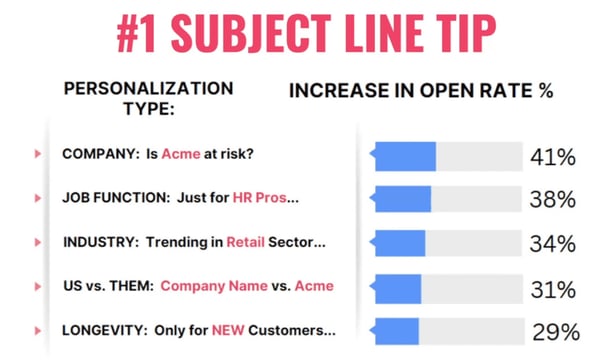
Adapting Cross-Channel Strategies
Take inspiration from attention-grabbing techniques in other marketing channels:
- Use video thumbnails in email (linking to full videos) to mimic the success of video ads
- Incorporate interactive elements like polls or quizzes directly in the email
- Use scroll-triggered animations to keep readers engaged as they move through your email
The Power of Visual Hierarchy
Guide the reader’s eye strategically:
- Use contrasting colors to highlight critical information
- Incorporate white space effectively to avoid overwhelming the reader
- Use directional cues (like arrows or a person looking at your CTA) to subtly direct attention
You must hold your audience’s attention throughout your email. Each element – from your subject line to your call-to-action (CTA) – should keep your reader engaged and moving toward your desired action.
Email Marketing Pro Tip: Use your marketing automation system to track which personalized subject lines and opening techniques work best for different segments of your audience. Based on this data, continuously refine your approach.
D – Direct: Getting Straight to the Point
Time is a luxury our readers don’t have. Once we’ve captured their attention, we must deliver our message quickly and effectively. The “Direct” component of our ADHD email marketing strategy is all about clarity, conciseness, and impact. Here’s how to make every word count:
The Art of Clarity
- Start with your core message: Begin each email with the most essential information. Ask yourself, “If they read nothing else, what do I want them to know, and what do I want them to do next?”
- Use the inverted pyramid structure: Present the most crucial information first, followed by supporting details.
- Eliminate jargon and buzzwords: While industry terms demonstrate expertise, overuse can obscure your message. Aim for clarity over complexity.
Directly Aligning Email with Your Content Strategy
B2B email marketing is as much about strategically delivering the right content to our audience as it is about pushing for a sale. Sending emails is about distributing relevant information throughout the buyer’s journey and is an essential part of your content marketing strategy.
This is vital for captivating leads and guiding them through their decision-making process. Here’s how email marketing fits into this strategy:
- Top of Funnel (ToFu): Attract and educate a broad audience by showcasing your category, challenging industry conventions, addressing problems and solutions, and discussing trends. Send informative content like industry insights, blog posts, and infographics to establish your brand as a thought leader.
- Middle of Funnel (MoFu): Nurture leads with valuable information, examples, and the benefits of your solutions. Offer case studies, whitepapers, webinars, and guides to educate prospects and highlight the value of your solutions.
- Bottom of Funnel (BoFu): Focus on conversion by emphasizing case studies, testimonials, and presenting results. Use compelling call-to-actions, success stories, product demos, and free trials to convert leads into customers.
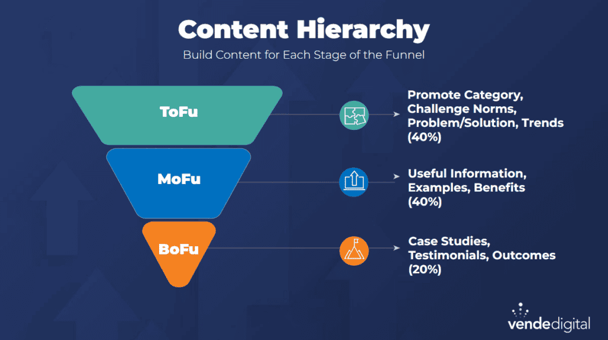
By guiding your prospects through each stage of the funnel with relevant information, you’ll build trust and authority by adding:
- Relevance: Ensure that the content delivered through emails is highly relevant to the recipient’s current stage in the buyer’s journey.
- Value: Each email should add value, whether educating, informing, or convincing your leads.
- Direction: Use emails to direct recipients to other valuable content, such as blogs, webinars, and case studies, available on your website or landing pages. This integrated approach keeps the engagement continuous and consistent.
- Become the Go-To Resource: Your buyer personas are getting spammed with generic, low-quality content that lacks originality and fails to add value. Set your email strategy apart by delivering content that makes your company the go-to resource in your industry.
Structuring Your B2B Email for Quick Comprehension
- Use short paragraphs: Aim for 2-3 sentences per paragraph. This improves readability, especially on mobile devices. Leverage AI enablement tools like Jasper and Grammarly to help shorten your copy.
- Incorporate subheadings: Break your email into clear sections, each with a descriptive subheading. This allows for easy scanning.
- Leverage white space: Don’t be afraid of empty space. It gives your content room to breathe and makes it less overwhelming.
- Use bullet points for key benefits or features: This makes information easy to digest and remember.
- Incorporate numbered lists for sequential information: Perfect for step-by-step processes or ranked items.
- Bold key phrases: But use this sparingly – too much bold text loses its impact.
Eliminating Fluff and Focusing on Value
- Be ruthless in editing: After writing, challenge every sentence. Does it add value? If not, cut it.
- Use specific, quantifiable data: Instead of “Our solution improves efficiency,” try “Our clients see an average 27% increase in productivity within three months.”
- Replace adverbs with stronger verbs: Instead of “greatly improve,” use “transform” or “revolutionize.”
Targeting Specific Decision-Makers
- Tailor your message to the buyer persona’s role. A CFO will have different priorities than a CTO, so adjust your focus accordingly.
- Address their pain points and objections: Use your CRM data to reference challenges unique to their position or industry.
- Anticipate and answer their questions: Put yourself in their shoes and address likely concerns proactively.
The 5-Second Test
Before sending, apply the 5-second test:
- Can someone grasp your main point in 5 seconds of scanning?
- Is your call-to-action (CTA) immediately clear?
- Does the email’s structure guide the eye to critical information?
Being direct doesn’t mean being abrupt or unfriendly. It’s about respecting your reader’s time and delivering value efficiently. By mastering the art of directness, you ensure that even if your recipient only skims your email, they’ll still grasp your core message and the action you want them to take.
Email Marketing Pro Tip: Create dynamic content blocks using your marketing automation system. This allows you to maintain a direct, focused message while tailoring specific sections to different audience segments.
H – Human: Injecting Personality into Your Emails
Why do B2Bs fall into the trap of dry, corporate communication? They often believe they are selling to companies, not people. The “Human” element of our ADHD email marketing approach is about creating a genuine connection with your reader. Here’s how to make your emails more personable and engaging:
Finding the Right Tone for Your B2B Audience
- Understand your audience’s communication style: Are they formal or casual? Do they appreciate humor? Use your CRM data and past interactions to guide your approach.
- Develop a brand voice guide: Ensure consistency across all communications while maintaining a human touch. AI tools can be helpful here. They can analyze your content, help you develop your brand voice, and ensure that future content you create aligns with your voice.
- Adapt your tone to the email’s purpose: Is it a sales pitch? A customer service email? Tailor your tone accordingly to achieve the desired outcome.
Storytelling Techniques for B2B Emails
- Use mini case studies: Share brief success stories your reader can relate to.
- Incorporate analogies: Explain complex concepts using familiar scenarios.
- Create a narrative arc: Even in short emails, you can create a sense of beginning, middle, and end to keep readers engaged.
Using Conversational Language to Build Rapport
- Write as you speak: Read your email out loud. Does it sound natural?
- Use contractions: “We’re” instead of “We are” feels more conversational.
- Ask questions: Engage your readers by prompting them to think or respond.
Incorporating Appropriate Humor and Personality
- Use industry-specific jokes or references: Show that you understand their world.
- Share personal anecdotes when relevant: This can help create a more human connection.
- Be careful with sarcasm or irony: These can be easily misinterpreted in written form.
Leveraging Visual Elements for Engagement
- Use GIFs strategically: A well-placed GIF can add personality and break up text.
- Incorporate video content: Consider adding a short, personalized video message.
- Use custom illustrations or infographics: These can convey complex information in a more engaging way.
Balancing Brand Marketing with Sales-Focused Content
- 80/20 rule: Aim for 80% valuable content and 20% promotional material.
- Share industry insights: Position yourself as a thought leader, not just a vendor.
- Use social proof: Incorporate testimonials or client logos to build trust.
- Share your Point of View to help differentiate your company from competitors.
Advanced Email Marketing Personalization: The Hulu Method
To take your email personalization to the next level, consider implementing what we call the “Hulu Method.” Just as Hulu suggests new shows based on your viewing history, you can use a similar approach in your B2B email marketing campaigns:
- Monitor Content Consumption: Use tools like HubSpot to track how your prospects interact with your content. What blog posts are they reading? Which webinars have they attended? What downloads have they accessed?
- Send Tailored Suggestions: Based on this data, create and send personalized content recommendations. This approach turns your email marketing campaigns into a “choose your own adventure” experience for your prospects. Example: “Reference past interactions or content engagement: “Since you enjoyed our webinar on AI in marketing, here are a few other items we think you’ll enjoy…”
By consistently offering relevant content, you’ll increase engagement rates, drive more traffic to your site, and gather valuable data to continue to improve the information you provide.
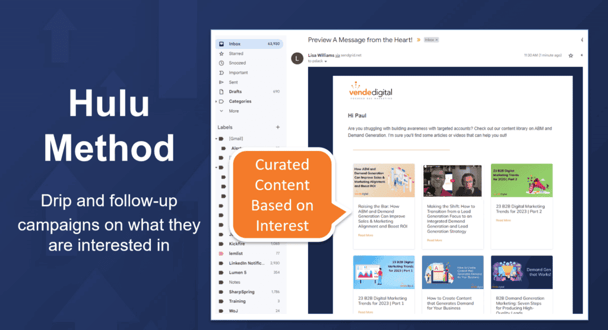
Showing Empathy and Understanding
- Acknowledge current industry challenges: Show that you understand their pain points.
- Offer genuine help: Sometimes, the most human thing is to offer assistance without expecting immediate returns.
- Be transparent: If there’s been a mistake or delay, own up to it honestly.
Let your personality shine, but remember that being “human” in your emails doesn’t mean being unprofessional. It’s about finding the right balance between professionalism and personality. By injecting a human element into your communications, you’re more likely to build lasting relationships with your B2B clients.
Email Marketing Pro Tip: Use your marketing automation system to segment your audience by demographics, firmographics, and communication preferences. Some recipients prefer a more formal tone, while others respond better to a casual approach.
D – Direction: Guiding Your Reader to Action
The “Direction” component of our ADHD email marketing approach is about clearly and compellingly guiding our reader toward our desired outcome. Here’s how to master this final critical element:
Crafting Clear and Compelling Calls-to-Action (CTAs)
- Be specific and action-oriented: Instead of “Learn More,” try “Download Our 2024 MarTech Guide.”
- Create urgency without being pushy: “Reserve Your Spot – Only 50 Seats Left” is more compelling than “Sign Up Now.”
- Use first-person language: “Start My Free Trial” can outperform “Start Your Free Trial.”
Strategic Placement of Call-to-Action Messages
- Primary call-to-action (CTA) above the fold: Ensure your main action is visible without scrolling
- Secondary CTAs throughout Provide alternative actions for those not ready for your primary ask
- Final CTA at the end: Reiterate your main ask after you’ve built your case
Using Design Elements to Highlight Your Direction
- Use contrasting colors for CTA buttons: Make them stand out from your email’s color scheme.
- Implement directional cues: Use arrows or images of people looking toward your CTA.
- Create white space around CTAs: Give them room to breathe and grab attention.
Providing Value-Driven Reasons to Take Action
- Clearly articulate the benefit: “Get the report that’s helped 500+ CMOs increase ROI by 30%.”
- Address potential objections: “No credit card required – start your trial in 60 seconds.”
- Use social proof: “Join 300+ marketing leaders who’ve already registered.”
Aligning Email Marketing Goals with Overall Marketing and Sales Objectives
- Map each email to a specific stage in your funnel: Is this email meant to generate leads, nurture prospects, or close deals?
- Set clear, measurable goals for each email: e.g., “Increase webinar sign-ups by 15%.”
- Ensure continuity in the user journey: Your email CTA should lead to a landing page that matches the message and design.
Leveraging Automation for Timely, Relevant Emails
Your email marketing strategy should leverage automation tools like HubSpot to enhance efficiency and effectiveness significantly. Here are some best practices:
- Lead Nurturing Workflows: Set up automated workflows triggered by specific actions (like downloading a whitepaper or visiting pricing pages). Use these triggers to send targeted, relevant content that moves leads through the funnel.
- Event-Based Emails: Create triggers based on webinars, trade shows, or product launches: Automate follow-ups, reminders, and post-event nurturing sequences to maintain engagement.
- Lead Scoring and Sales Alerts: Implement lead scoring based on interactions with emails and website visits. Use triggers to notify sales teams when leads reach a specific score threshold, ensuring timely follow-up.
- Re-Engagement Campaigns: Set triggers for contacts showing decreased engagement (like not opening emails for a specified period). Automate re-engagement campaigns with compelling content or special offers to revive interest.
- Behavior-Based Triggers: Use HubSpot’s behavioral triggers (like website visits, content downloads, or form submissions) to initiate targeted email sequences that align with the prospect’s stage in the buying journey.
- Feedback and Surveys: Automate follow-up emails triggered after specific customer interactions (like completing a purchase or attending a webinar). Use these triggers to gather feedback and improve customer experience.
- Dynamic CTAs: Change your CTA based on the recipient’s past interactions with your content
- Decision Trees: Map out different paths based on how recipients engage with your emails
The Power of the Next Step
Effective B2B email marketing is about more than just asking for the sale. It’s about guiding your reader through a journey, providing value at each step, and making it clear and compelling for them to take the next action.
- Provide clear “what’s next” information: What should they expect if they click your CTA?
- Offer multiple ways to engage: Some may prefer a demo, others a white paper – give options.
- Use confirmation emails as opportunities: After they take action, guide them toward the next step in your funnel.
By mastering the art of direction, you ensure that the attention you’ve captured, the direct message you’ve delivered, and the human connection you’ve established converge toward achieving your email marketing goals.
Email Marketing Pro Tip: Create sophisticated, behavior-based email flows using your marketing automation system. For example, if a recipient clicks on a CTA but doesn’t complete a form, trigger a follow-up email addressing potential concerns.
Putting The ADHD Method To Work For You
Let’s see how these elements combine to create a powerful B2B email. Here’s a step-by-step guide to constructing your email.
Step One: Attention-Grabbing Subject Line and Preview Text
- Craft a compelling subject line using power words or personalization
- Create preview text that complements and expands on the subject line
Step Two: Direct Opening
- Start with your most important message or a striking statistic
- Use short paragraphs and clear, concise language
Step Three: Human Connection
- Incorporate a personalized element or relatable anecdote
- Use conversational language that resonates with your audience
Step Four: Clear Direction
- Include a prominent primary CTA above the fold
- Reinforce with secondary CTAs throughout the email
Step Five: Creative Element
- Add an unexpected or interactive element to stand out
- Ensure the creative aspect supports your main message
Example of a B2B Email Using the ADHD Approach
Subject: [Company Name], is your MarTech stack costing you clients?
Preview: Discover how top CMOs are saving $100K+ annually…
Body:
Hi [First Name],
Did you know that 67% of marketing teams are overspending on underutilized MarTech? Your stack might be draining your budget instead of driving results.
At Vende Digital, we’ve helped companies like yours streamline their MarTech and boost ROI by an average of 40%. Here’s how:
[Interactive Infographic: “Build Your Ideal MarTech Stack”]
Like you, I’ve been in the trenches of marketing ops. I remember the frustration of juggling dozens of tools that promised the world but delivered headaches.
That’s why we created our MarTech Optimization Platform. It’s not just another tool – it’s your command center for marketing efficiency.
Ready to stop wasting money on MarTech bloat?
[CTA Button: “Get My Free MarTech Audit”]
Not quite ready for an audit? No problem. Check out our latest case study to see how [Relevant Company] saved $150K and increased lead quality by 25%:
[Secondary CTA: “Read the Case Study”]
Looking forward to helping you transform your MarTech stack,
[Your Name]
MarTech Optimization Specialist
Vende Digital
P.S. Our free MarTech audit spots are limited. Secure yours now to start saving:
[Final CTA Button: “Yes, Optimize My MarTech!”]
By thoughtfully applying the ADHD framework to your email marketing strategy, you can create B2B emails that capture attention and drive meaningful engagement and conversions. Your emails will stand out in crowded inboxes, resonate with your audience, and ultimately contribute to your business objectives.
Find Out Why Your Emails Aren’t Working With Our ADHD Diagnostic Checklist
Get our exclusive “ADHD Diagnostic Checklist for B2B Email Marketing” emailed right to your inbox. This powerful checklist will help you:
✓ Identify key areas for improvement in your email campaigns
✓ Ensure your emails capture Attention, communicate Directly, maintain a Human connection, and provide clear Direction
✓ Boost your open rates, click-through rates, and conversions
Don’t let another email campaign underperform. Get your free checklist now and start optimizing your B2B email marketing efforts today!

By downloading this checklist, you’ll have a handy reference guide to ensure your B2B emails are always working at peak performance.
Mastering B2B Email Marketing with the ADHD Approach
As fellow B2B marketers, we understand the unique challenges and opportunities that email marketing presents. You need practical tools and strategies to reach your target audience, nurture leads, and drive conversions. You want higher open rates, better click-through rates, and more qualified leads that convert into sales.
The ADHD approach we’ve explored in this article – Attention, Direct, Human, and Direction – addresses these core needs and desires. By implementing this framework, you can:
- Capture Attention in crowded inboxes, reducing the fear of your emails being ignored or marked as spam.
- Communicate Directly, ensuring your message resonates and delivers clear value to your audience.
- Maintain a Human connection, differentiating your brand and building lasting relationships with prospects and clients.
- Provide clear Direction, guiding your readers towards meaningful actions that drive business results.
The ADHD framework can transform your B2B email marketing from a source of frustration into a powerful engine for business growth. As you implement our framework and work through the checklist, remember you’re not alone on this journey.
Ready to revolutionize your B2B email marketing efforts?
Whether you require support with strategy, content, design, or analytics, our team has you covered. Don’t allow underperforming emails to impede your progress. Contact Vende Digital today for tangible outcomes in your email marketing endeavors.
